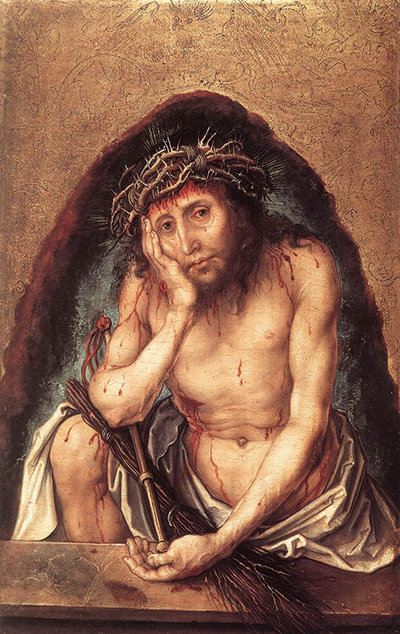This painting, sometimes known instead as Christ as the Man of Sorrows, was completed in around 1493 by Albrecht Durer and can now be found within the permanent collection of the Staatliche Kunsthalle in Karlsruhe, southwestern Germany.
The painting in front of us here depicts Christ suffering right before our eyes, shortly after he had been mistreated by the soldiers who have imprisoned him. He leans his face on his right hand, contemplating his impending death as he awaits his own crucifixion. This relatively brutal artwork displays blood pouring from Christ himself, whilst some of the instruments used to cause this pain are included within the composition. We find, for example, a whip and bundle of birches which presumably were common methods of torture during his time. Whilst Durer would not normally produce such honest but depressing depictions, it was entirely common within the Renaissance era more generally to focus on the pain and suffering of this figure. Artists would really just vary in how graphic they made these paintings, which in turn would alter the atmosphere of each artwork from distressing to respectful, or even perhaps celebratory. Christ appears many times throughout Durer's career, across a number of drawings, paintings and etchings.
Some technical items to note here is how the left arm is pushed forward onto a ledge close to us - this helps to produce just a small sense of perspective. The facial expression tells us of his upcoming demise, and also that Christ himself was entirely aware of what was about to occur. The use of blood in a realistic manner makes his emotions even more real and help us connect directly with this iconic figure's emotions. It took many years before this piece was correctly identified as from Durer's hand, partly because he did not sign it. Research has suggested that it was only later in his career that he would use his customary signature and he would also have been travelling around Europe at the time of this particular piece.
The venue which holds this piece, Staatliche Kunsthalle in Karlsruhe, is a small provincial gallery that actually holds an impressive permanent collection. You will find many of the finest European artists included within its walls, and another piece from Durer featured here is The Four Riders of the Apocalypse. Aside from the inclusion of this artist, there are also many other German artists featured throughout this institution which is a must-visit for any art followers who happen to be close by. Rochers, pins et mer à l'Estaque by Paul Cezanne, People by a Blue Lake from August Macke and Preparing for Dancing School by Antoine Le Nain are just a few of the interesting items to look out for. They also feature some other great names such as Franz Marc, Édouard Manet and Camille Pissarro too, making it a highly prized and perhaps underrated collection. Germany is blessed with a whole host of regional galleries which have allowed its rich art history to be spread fairly evenly around the country, allowing many more residents to learn and enjoy some of these items than would have been the case if it was all more centralised.




